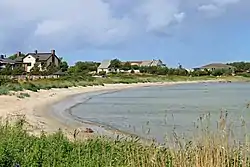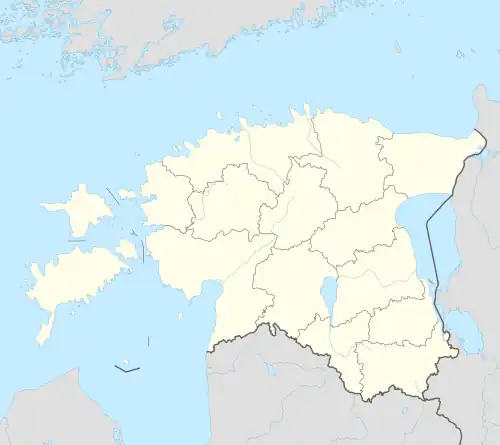Rohuneeme
Rohuneeme is a village in Viimsi Parish, Harju County in northern Estonia.[2] It is located about 14 km (9 mi) northeast of the centre of Tallinn, situated on the northern end of the Viimsi Peninsula. As of 2011 Census, the settlement's population was 440.[1]
Rohuneeme | |
|---|---|
 | |
 Rohuneeme Location in Estonia | |
| Coordinates: 59°33′42″N 24°48′01″E | |
| Country | |
| County | |
| Municipality | |
| First mentioned | 1375 |
| Population | |
| • Total | 440 |
| Website | www |
The northernmost cape of the peninsula is named Rohuneem (literally: Cape of Grass).
The island of Aegna, which administratively belongs to Tallinn, is located about 1.5 km northwest of Rohuneeme. There are also two small islets Kräsuli and Kumbli located in the straits between, which belong to Rohuneeme.
Rohuneeme was first mentioned in 1375 as oppidum Longenes. The narrow strait between Kräsuli and Aegna was known as Wulfs Sund. It has been known as a point for pirates to ambush the Novgorodian merchant ships which brought valuable goods to Tallinn. According to one hypothesis, the strait could have been the location of the battle at Iron Gate in 1032, mentioned in Russian chronicles. In battle, which though is usually located to northern Russia, Novgorodians led by Ulf Ragvaldsson suffered heavy loss.[3]
In the Middle Ages Rohuneeme was settled by Coastal Swedes. During the Soviet times a missile base was located on the southern side of the village.
There is a harbour, store and a cemetery with chapel located in the village.
The second President of Estonia Lennart Meri lived on the cape of Rohuneeme.
References
- "Population by place of residence (settlement), sex and age". Statistics Estonia. 31 December 2011. Retrieved 31 May 2013.
- Classification of Estonian administrative units and settlements 2014 (retrieved 27 July 2021)
- Mäesalu, Ain (2012). "Could Kedipiv in East-Slavonic Chronicles be Keava hill fort?" (PDF). Estonian Journal of Archaeology. 1: 199. Retrieved 27 December 2016.
